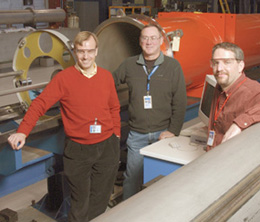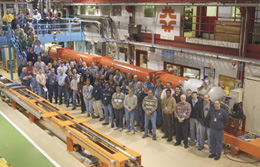 |
|
LHC magnet test by Mike Perricone Fermilab's Technical Division has completed highly successful tests of the first superconducting quadrupole assemblies for the US LHC Accelerator Project. The 19-foot, 12,000-pound magnets, part of an overall $531 million effort in the U.S., are bound for the Large Hadron Collider under construction at CERN, the European Particle Physics Laboratory in Geneva, Switzerland. “The first results have been very good,” said Fermilab LHC project manager Jim Kerby, of the lab’s Technical Division.“They’ve performed well above where they need to be for the [LHC operation]. In fact, they’ve performed better than any magnets we’ve ever made here.”
The LHC superconducting magnets are designed to reach a peak magnetic field of 9 Tesla; superconducting magnets at Fermilab’s Tevatron reach 4.4 Tesla. “In terms of production accelerator magnets,” said Fermilab’s Jim Strait, the US LHC project manager,“this is about as high a field as anyone has ever achieved. These are some of the best production accelerator magnets ever made.” The system is working. With outstanding performances by these first two assemblies at super- conducting temperatures, Kerby added,“we know that we do not have a systematic problem with our production process. That doesn ’t rule out random problems, but it lets us know that our overall process is working. It’s a testimony to good quality assurance practices and the dedication of everyone who has worked on the project.” The tests have been performed at Fermilab’s Industrial Center, on quadrupole assemblies destined for the beam interaction points at LHC. The assemblies incorporate two Fermilab-produced quadrupoles (focusing magnets) joined with a CERN-designed correction dipole (steering magnet), with the components stretching about 40 feet. The assemblies are slid into a vacuum vessel and chilled with superfluid helium to around 2 kelvins (2 degrees celsius above absolute zero). Each half of the assembly is tested individually. The magnets are “trained ” with electric current flowing through them until they quench, or rise above superconducting temperatures. When the magnets quench, they “remember ” the levels of current flow they’ve experienced, and the intensity of the magnetic field they have generated. If all goes well, they will equal or surpass those standards in succeeding thermal cycles, until they have reached their performance goals. For their role in the LHC, the magnets are expected to generate a magnetic field gradient of 205 Tesla per meter, with some portions requiring 214 T/m. Fermilab is expected to train the magnets up to 230 T/m, providing a high level of confidence for their performance under the most stringent experimental conditions in the collider. When tested in 2001, the Fermilab prototype quenched at an electrical current just under 12,000 amperes. The first half of the first production assembly went all the way to 13,000 amperes without quenching, reaching a field gradient of 233 T/m in the first thermal cycle. The second magnet reached 12,710 amperes, producing a gradient of 229 T/m on its first quench, then hit 12,955 amperes and 232 T/m on the second quench — again, above the target of 230 T/m.
“If I could bottle this kind of result, I would,” Kerby said. While production and testing continue on the remainder of the 18 Fermilab magnets, another production process is beginning. The Fermilab team will receive 18 LHC magnets produced at KEK in Japan. At Fermilab, they will be assembled into their cryostat structures before being shipped to CERN. Brookhaven and Lawrence Berkeley National Laboratories round out the U.S. collaboration on LHC accelerator components. Brookhaven has built and tested beam separator dipole magnets to be used in specialty regions around the 27-kilometer (17-mile)LHC ring. Of an allotment of 20 magnets of four different types, Brookhaven has completed 13, tested eight, and shipped one to CERN. Brookhaven is also testing superconducting cable produced in Europe. Berkeley is working with Fermilab on superconducting cable; producing absorbers to protect magnet components from low-angle debris in the collision region, and building feed boxes to provide utilities for the magnets — power, cryogens, vacuum and instrumentation. Fermilab was a pioneer in superconducting accelerator magnets, with more than 1,000 incorporated into the Tevatron, which was completed in 1983. The US LHC effort means superconducting magnet production has returned to Fermilab in a big way. “We have developed the engineering, scientific and technical staff to produce the highest- performing magnets in the world,” Strait said. “With this project, we have maintained and extended our leadership in superconducting magnet technology.”
ON THE WEB: |

